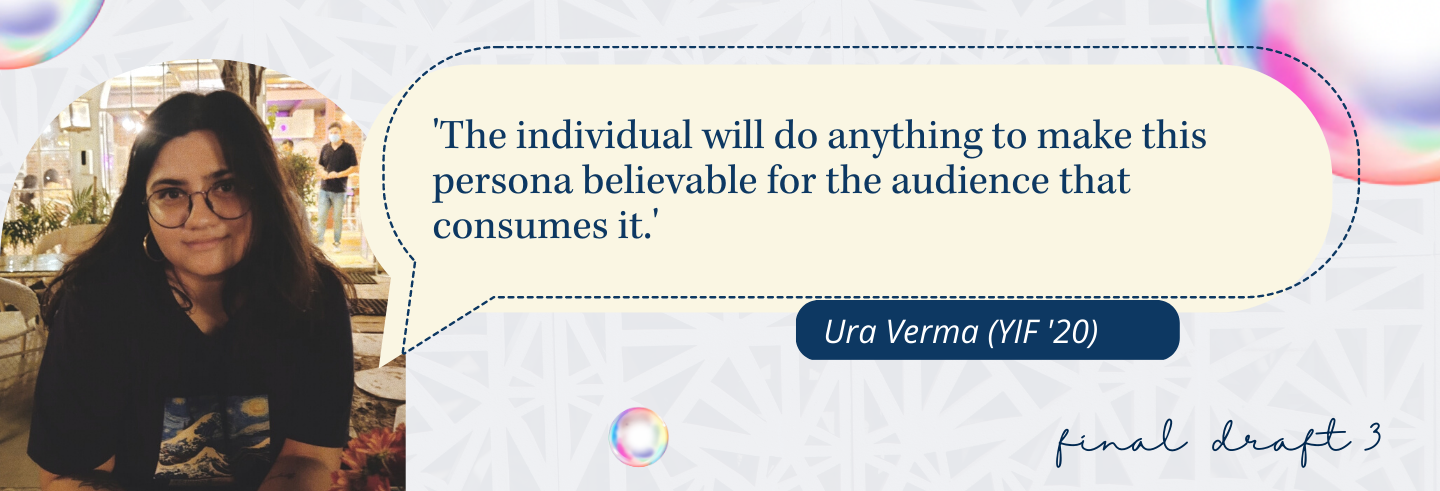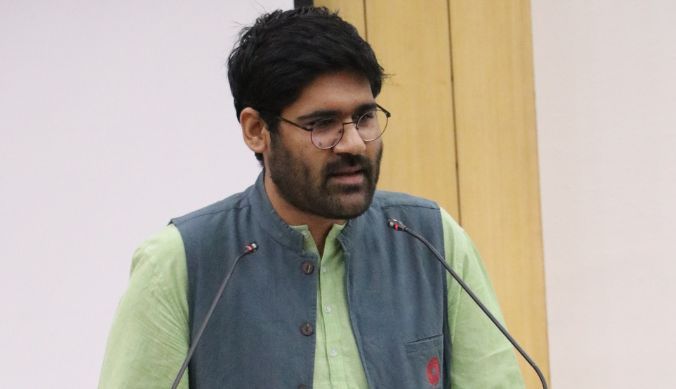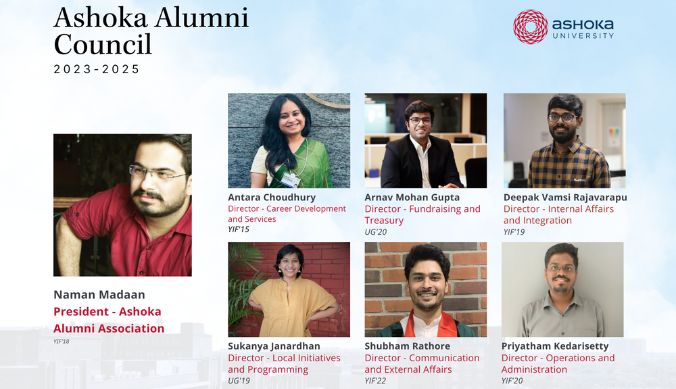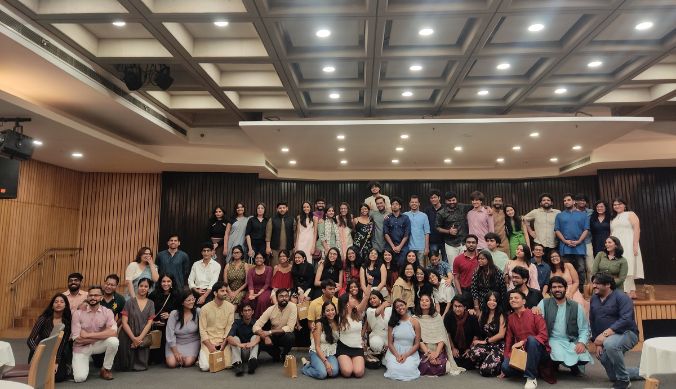‘Mirror, Mirror on the Wall’
Featuring Ura Verma’s creative piece that developed as an original project over her term at the Young India Fellowship
Abstract:
The fluidity and anonymity of the virtual world can be both exhilarating and debilitating at the same time. Reflecting on her growing-up experience of social media platforms like Finsta and Ask. fm, Ura Verma dares to ask the mirror on the wall: Where can the ‘real self’, if any, be located in the mirage of personas?
Article:
The polished reflective surface that we use every day to view our physical selves was first invented around 200 years ago in 1835 by a German chemist called Justus von Liebig; it was the Mirror. Since the creation of mirrors, commercial activity has commenced; it has changed the way people live their lives. Not only has it transformed the way we walk through society, and look at fashion, beauty, and culture, but it has also given us a perspective that none of our ancestors could have imagined: “a perspective on how we look to the rest of the world” (Heichelbech). This changed perspective has made the meaning of the word Mirror even more relevant. The word is of Latin origin, where “Mirari” means to admire (“Mirror”, Etymology Dictionary). No wonder that with the advent of the mirror, not only have we become obsessed with admiring ourselves, but we have also become obsessed with the idea of being admired by everyone else. This obsession has reached such a high that with the coming of each generation, humans all around the world will do anything to get this admiration; even if that means distorting our personalities to be accepted in a society where the parameters of acceptance are changing day by day. In this paper, I will not only attempt to understand the mirror as a cultural object, but in addition will also delve into the categories of mirroring as a phenomenon in the realms of social media, and how it affects online personas and identity formation through the exploration of alternative accounts and Finstas. 1 Through these explorations, I will show how it is impossible for us to portray our real selves online through Finstas or alternative accounts because of the constant mirroring that we indulge in on social media.
Part One—Sharp Objects
What we often seem to forget and fail to understand is that once an object becomes a crucial part of everyday life, it is not just an object any more; it becomes a part of our culture. Chopsticks, according to the California Academy of Sciences, were developed in China about 5,000 years ago. The earliest evidence of the use of chopsticks, or chopstick-like structures was probably twigs, and then it further developed into a pair of sticks of equal length. By around 500 AD, the use and idea of chopsticks had spread to various other Asian countries. The usage of chopsticks became so popular that stories and lore were being made about and around it (Bramen). The chopstick that we talk about, is not just a utensil that we use to eat and cook; it has now become a part of a cultural identity. The same thing happened to the mirror. After its introduction, it became such a daily need that it started transforming into a universal culture. This universal cultural identity of the mirror then reflected itself in metaphors in various works of art. Laurie Schneider in her essay “Mirrors in Art” discusses how “art is a mirror”; it reflects the society we belong to, with all its customs, beliefs, norms, beauty, and, most importantly, it reflects the artist (Schneider 283). Since the artist is a creation of the culture and society that surrounds them, art is essentially reflecting itself. If we solely stick to the qualities of the mirror, it will almost always reflect what is on the surface; it reflects what exists. However, when one realises that what exists is not what is accepted, the mirror then often starts to reflect a desire, a fantasy, an acceptance, an ideal self that we all want to reach. When this idea starts to permeate within the very being of an individual, not only does the culture and society become a mirror for us, but we become a mirror for them. We make ourselves believe that we desire the things they want us to desire and become a reflection of society but without any of our agency.
One of the most alarming repercussions of not having full agency over our identity, physical or otherwise, is the deterioration of self-esteem and how it affects every aspect of our lives. The psychological impact of society on how we are supposed to completely change the way we perceive ourselves. The ideal of perception has shifted from what we are to what we ought to be to feel accepted. I believe that it hits the way we look at our bodies. The obsession this culture has with perfectionist beauty standards is a huge risk factor when it comes to disorders such as body dysmorphia, where individuals end up worrying about the flaws in their appearance, which are often unnoticeable to others. These mental health conditions often lead to eating disorders where individuals take active negative steps to change the appearance of their bodies to align with the beauty standards that their culture and society constantly reflect on them (Kaur 5). Moreover, the American Society of Plastic Surgeons, in its “2017 Top Five Cosmetic Plastic Surgery Procedures” article states that most of cosmetic surgical procedures include breast augmentation, liposuction, nose reshaping, eyelid surgery, and tummy tuck. Individuals all around the world are compared to bodies and beauty standards that are unrealistic and unachievable naturally in most cases. We are not beautiful if we do not have an hourglass body, six-pack abs, the perfect nose, the perfect height, the desired size of breasts, flawless skin, and the list goes on. We need to realise and see the trends and their direct connection with how societal institutions disempower us to embrace our uniqueness, only to serve the purpose of perfectionism and conformity.
Almost all dominant social structures treat diversity and individuality as a pathogen that needs to be either prevented or cured at every step. This purpose that these structures want to achieve is not only highly prevalent in the constant need to change our physical appearance but is now creeping into the way we portray ourselves to others; our personalities. Just as we try to mould ourselves physically to fit into socially and culturally created beauty standards, we also consciously or unconsciously try to mould our personalities to fit the ideal standards of someone who can be ‘liked’. And frankly, who does not want to be liked? We become so involved in pleasing society to fit in that we often end up fighting our own true selves to create accelerated personas. With the advent of social media platforms, these personas have become easy to make. It has become effortless because now, we do not have to step outside our sheltered homes to access culture. Technology has immensely increased the presence of social media and has bombarded us with an ideal image which is taking us far away from our true unique selves. Personas then become a dominant second nature, a tool to please and feel accepted. However, an important question is what is a persona? Is it a part of an individual? Is it a character they are playing? Or is it a specific aspect of their personality that overpowers their authentic self? While trying to understand how art is embedded in unreality, Jean-Paul Sartre accidentally stumbles upon what we call a persona. In “The Work of Art”, he explains:
It is well known that certain amateurs proclaim that the actor does not believe in the character he portrays. Others, leaning on many witnesses, claim that the actor becomes identified in some way with the character he is enacting. To us these two views are not exclusive to one another; if by “belief” is meant actually real it is obvious that the actor does not actually consider himself to be Hamlet. But this does not mean that he does not “mobilize” all his powers to make Hamlet real . . . he lives completely in an unreal way … (Sartre 222)
A persona is nothing but a character, a role that individuals take up to be perceived in a certain way, according to the situation or the experience that they belong to in real-time. In the same fashion as Sartre’s unreality, personas too are a belief, but that does not mean that the persona is the individual. There still exists a distance between the persona and the individual portraying the persona. Despite this distance, the individual will do anything to make this persona believable for the audience that consumes it. To make that consumption possible and successful, the portrayer will always be mirroring what the audience wants and will constantly be changing or enhancing its personas. Hence, “It is not the character who becomes real in the actor, it is the actor who becomes unreal in his character” (Sartre 223). By using the term ‘unreal’, Sartre is trying to explain that it is not that the character the actor is playing becomes real, but the actor willingly lets go of their identity and becomes ‘unreal’ for the sake of the character. Similarly, when we portray a persona, it is not that the persona is real, but the individual portraying the persona compromises on some part of their identity and reality to make the persona acceptable.
This type of persona formation is vastly seen on social media platforms, where the creation of a persona precisely depends on how good you are at the art of mirroring. The concept of mirroring is closely related to the ‘ideal persona effect’, which talks about how presentation on social media has become so important that individuals are now becoming hyper-aware of what they are posting (Halpern et al. 8). Mirroring, then, holds a very important position in the process of creating this ideal persona. As previously mentioned, when one realises that what they are is someone that does not fit the societal norms of one’s online culture, they start to mould their personality accordingly. This moulding of one’s personality happens through mirroring; where individuals consciously or unconsciously imitate “the gestures, speech pattern, or attitude of another” (“Mirroring”, Wikipedia). “The concept often affects other individuals’ notions about the individual that is exhibiting mirroring behaviours, which can lead to the individual building rapport with others” (“Mirroring”); this happens in every aspect of our lives, including our presentation on social media. We tend to mirror the culture and personalities that are portrayed to us, to build a rapport with the community we want to belong to; and hence keep indulging in this phenomenon to gain acceptance. The repercussion of mirroring is the creation of an unrealistic persona that also acts like a mirror for society. Not only do we tend to realise the unrealistic standards of social media, but we also mirror these standards by creating personas that fit the norm and hence validate this “ideal persona effect” (Halpern et al. 8). The constant need and pressure to keep mirroring for the sake of being relevant and accepted leads to a radical duality within an individual. This duality first starts by trying to fit in and ends with an urge to break out. This urge of a non-conformist that comes from within an individual who is also trying to conform at the same time, is reflected through a phenomenon seen on Instagram called a Spam Account or a Finsta. Further in the article, we will be discussing in greater detail what Finstas and alternative accounts are, and how they are nothing more than the result of constant mirroring.
Part Two—Best of Both Worlds?
My journey of discovering this world of social media, spam accounts, and their repercussions began when I was very young. In tenth grade I realised that it was important for me to become someone I am not, to gain acceptance. Yes, that is a fairly young age, and no, it is not very uncommon for people to feel the exact same way. For me, it started with the advent of this question-and-answer site called “Ask. fm”; it is exactly what you think it is. People ask you questions anonymously, and well, you answer them. It first started as something you just did in your free time; your friends ask you irrelevant questions and you answer them, just to play around. After a couple of months of its popularity, the site became something it was not. Teenagers from all around the country started gaining a large following through this website, simply by answering questions in ways that would shock the audience; by answering questions that you would normally not give answers to in real life. I gained most of my audience through being “Ask Famous”. For a girl who didn’t really fit in at school, the online world became my solace, and I would do anything to gain that acceptance. It did not take long before I started getting noticed in places such as school fests and parties. It was something that I had never experienced but it was also something that I had always wanted as a child; to be somebody. It is exactly like winning. Once you start winning, you do not want to lose. Once you start gaining recognition for that win, the very loss of that recognition makes you work harder to win.
I had to shift this online Ask. fm persona that I had created for all my other social media accounts. Why? you ask. Because I thought it was an obligation. I believed that my persona is what people wanted. This lasted for a couple of months when I would noticeably change my appearance, the way I spoke, and even my thoughts to the extent that it became difficult for me to even recall who I actually was. The essay “Online Inspiration and Exploration for Identity Reinvention” explains how “Online self-representation is highly dependent on perceived audience” (Haimson et al.). The spectator for every online persona is always perceived by the persona, and just like the mirror, the online persona will always perceive what is on the outside. There is no actual evidence to back what the spectator actually feels, and hence the persona may also sometimes see what they want to see through this perceived spectator. The act of mirroring then performs a very different role, where it still takes place, but is distorted by our perception of what the individual is behind the reflection.
The first hint of unreality for me, was when people started referring to me not by my name, but by my Instagram username in public. That is when I truly realised that this persona I had created had taken an ugly form of reality. I understood that this was not online any more; people expected me to be a certain way, even when their screens did not separate us. Not only was I constantly giving people what they wanted online, but I started reciprocating offline as well. What I understood is that the world of social media has a mix of ‘social categories’; it may include your peers, family, acquaintances, love interests, and even strangers, and these various mixes of compositions drastically affect the kind of risks you may take online (Haimson et al. 3809). What I had forgotten in this high of living an unreality, was that people knew me in real life and not just through an app. Not only was my character unreal to me, but I had to become unreal for the sake of the character everywhere I went.
I played along for as long as I could, but after a point, I could feel the compulsion building up in me. If you have watched the Bollywood film Rockstar by Imtiaz Ali, you would know how Heer Kaul felt throughout the movie. She had to be the epitome of a perfect Indian woman, polite, shy, and mysterious. Heer belonged to a well-reputed family, and she believed that behaving the way that she did was the only mechanism through which she could be accepted by the people around her. In reality, she was the complete opposite of what she portrayed herself to be. I felt like Heer Kaul from Rockstar. The only difference between us was that she found an escape where she could be herself. For me, this escape came much later in the form of a Finsta account, which distorted my reality even more.
According to the Urban Dictionary, a ‘Finsta’ is “a spam Instagram account where people post what they are too afraid to post on the real account” (“Finsta”). Usually, when individuals are too afraid to do something because of an unseen force or possibly an untrue perception of reality, they find ways to face this fear by either doing what they want to do in secret with only a few people knowing about it, or they deal with it through outright rebellion and not following the social constraints that were earlier strapping them down in the first place. In the realms of the online social media world, where having a perfect reflection-created persona is important, a Finsta now is not only an escape but is also a clear act of rebellion. Carl E Pickhardt in his article “Rebel with a cause: Rebellion in Adolescence”, explains, “Although the young person thinks rebellion is an act of independence, it actually never is. It is really an act of dependency. Rebellion causes the young person to depend on their self-definition and personal conduct on doing the opposite of what other people want.” We are so afraid of portraying our real selves online because of our need for acceptance, that we think that having this alternative account that exhibits a completely opposite reality to ours will fill the void that we feel within.
This phenomenon of having a Finsta and knowing about the contents that lie behind the Finsta became slowly and steadily really popular. The universal connotations that came with having this alternative account meant that the public account that one has is not truly the real self, but this alternative spam or Finsta account is the true self. This is because one can post the things that one is afraid to post on the main account on this alternative account, and this account is also subscribed to by only a few close friends. Therefore, it is plausible to call this phenomenon a mixture of escapism and rebellion. Not only are we opening up our ‘real self’ online just to a few close friends to escape the pressure of a public account, but we also openly showcase that our Finsta does exist, as an act of rebellion. We create this Finsta account to break the social norms that we have been following till now, doing the opposite of what we are asked to do, thinking that maybe this distortion that we are facing in real life because of our online identity can be salvaged.
Part Three—You Never Existed
Marlon Jovi S Valencia, in her thesis “How Online Social Media Persona Affects Personal Identity and Self ”, talks about “Hidden Identity Online” (Valencia 9), where she explains, “Recently there has been a rise in taking on an alternative account to post about different things. …While there are limited eyes on someone’s alternative account, the account still exists. The presence, while supposed to be hidden, is still real” (10). “The Hidden Identity Online” (9) is a phenomenon that can be viewed through the lens of a Finsta account. The idea that we can get away from our created personas on our public accounts through the creation of an alternative account, and somehow press on the belief that “an alternative account is truer to one’s identity” (10) is a delusion that a lot of us tend to hide behind. Just as Valencia explains, that even though this alternative account is reachable to only a select number of people that the owner picks, the fact that it is still reachable, makes it embedded in reality. Logically, even though this alternative account is accessible to a select few, it does not imply that it is the closest to one’s true identity. The only thing a Finsta proves is the reality of another account, where you post things you usually won’t post on your main account. And hence it adds to the argument that “an alternative account is also part of the identity of a given person” (10) that we portray online. The general connotations that we give the Finsta—of it being our true identity— are something that we have created to break the norms of social media; to rebel and to escape. That is also what a portrayal of an online persona is all about; we provide characteristics of a persona, but that does not mean the persona is us.
Sandra Newman in her article “Possessed by a Mask” gives an interesting analogy between masks used in mysticism and the masks individuals wear online. She talks about how the earliest appearance of a mask was supposed to be in religious rituals, where, by wearing a mask, the devotees would let the spirit of God enter their body and act in ways that were alien to the individual wearing the mask (Newman). “In short, as soon as people put on masks, they begin to violate social norms” (Newman). The most important aspect of wearing the mask is that their personas would prolong, regardless of who is wearing the mask (Newman). When we upload a persona, essentially it is created through vigorous mirroring of the society we represent. These personas, hence, are not unique to us at all, since everyone around us is mirroring the same culture and society we belong to. The persona, then, does not become a personal entity; it is now in the public sphere, and has been accelerated through technology and culture. So then how can any of our online identities be who we actually are? Are we all really that similar?
When we put something out on social media, we should accept the fact that it is susceptible to mirroring, and in most cases, the content that we put out is a result of something that has already been mirrored. This is also one of the reasons why things become popular on social media: the constant act of mirroring. Finstas and alternative accounts have also gone through the same course of mirroring, which has led to their popularity. That is why most of these accounts have the same kind of content, the same circle of people involved, and the same kind of personas. If Finstas were the reality of one’s true identity, then none of the alternative accounts would be so similar.
Valencia argues that an alternative account “does not serve as an alternative person; if anything, having an alternative account only aids in one’s overall online composition” (10). Having a Finsta is not something groundbreaking that portrays one’s real identity. It is as performative and created as any other account because, at the end of the day, it is content that has been mirrored by similar accounts like it. According to a study called “Finsta: Creating ‘Fake’ Spaces for Authentic Performance”:
Humor and authenticity are values within Finsta communities. “Authentic” does not mean unperformed but is its own norm of performance enforced by the Finsta audience. Similarly, humor indicates that even when trying to be less curated, Finsta users are still trying to be something … (Dewar et al. 4)
What is humorous about having a Finsta account is its preaching of being authentic, but at the same time, being similar to all other Finsta accounts. It thrives on having the same kind of authenticity, the same kind of self-deprecating humour, the same kind of ugly pictures, and the same kind of mirroring that its cousin—the main account—has. If there are so many stark similarities between all Finsta accounts, then how can it be a depiction of our real identity? Because last I checked, personal identities are supposed to be unique to every individual.
The authenticity that we want to achieve on our Finsta accounts, as well as our main accounts, is constantly distorted by the act of mirroring and the achievements it brings us online or offline. Once we realise that something is giving us benefit, we tend to gain an appetite for it, regardless of what we have to give up for the appetite to be fulfilled. Once we notice an act or behaviour gaining popularity or overall social acceptance, we try our best to mimic it to gain the same. Mirroring not only is an essential tool for the observation of others but is also a tool that can be used to gain the same kind of acceptance and appreciation that the people around us are getting. This process then replicates itself so many times, and the consumption of it becomes so homogenous that authenticity becomes a sham, an act that needs to be fulfilled. This sham of authenticity can be seen on Finsta accounts, where to be authentic means to be the same kind of authentic. When the portrayal of authenticity is similar across all Finsta accounts, then are we ever really portraying our true selves? While writing this paper, I knew that I was heading into dangerous territories because talking about inefficient portrayals of the true self online in a very generalised way can be scary. It’s unsettling because some people may disagree with my argument entirely, and who am I to tell them that they are wrong? Humans are complicated. The way they portray themselves online or offline is complex and personal. Telling them that their online presence is not exactly who they are can cause turmoil, real-life turmoil. And even if we do keep these realities in mind, we still can’t shy away from the clear similarities between personalities that we see online. These similarities are apparent because mirroring has always been universal! You can see it in viral videos and online trends, and now it’s branching out to online personalities. Even though I believe in mirroring and how it presents itself online, this paper is not about proving a point. It’s more about questioning an individual’s online presence.
About the Author:
Ura Verma is a 24-year-old content marketer living in Gurgaon who loves to dissect human emotion and interaction and then write about it for her own pleasure. Belonging to a family of authors, people usually assume that she loved writing from the beginning, but that couldn’t be far from the truth. Ura started writing seriously in 2019 when she had no other choice but to attend the YIF critical writing programme at Ashoka University. Not taking it seriously at first, she slowly started losing herself in the world of words. Being mostly introverted, Ura found comfort in writing and made it her life. She believes that Ashoka saved her from a career path she would’ve never enjoyed. Besides writing, she is passionate about making music, art, technology, and philosophy. Ura currently works with a tech start-up aiming to provide financial freedom to all its users.
About YIF CW Programme:
The YIF Critical Writing programme is a unique, one-of-a-kind opportunity for Fellows to hone their critical thinking and writing skills under the able supervision of trained experts in the field. The CW programme employs a constantly evolving pedagogy, making learning and knowledge production more collaborative and dialogic. Preceptors at the YIF CW programme teach writing through a range of topics including but not limited to ‘History, Philosophy, and Anthropology of Science’, ‘Politics of Language and Multilingualism’, and ‘Education, Literacy, and Justice’.
About Final Draft:
The Final Draft is the annual journal of the YIF Critical Writing programme. It showcases the range in topic and genre, as well as the strength of writing in the highly diverse YIF student body. These pieces of writing, submitted by Fellows from various classes of the YIF represent only a small fraction of the variety and range of writing done over the years.
About our campaign:
Through our ‘Final Draft 3’ campaign, we hope to give you a glimpse into some of the styles and voices that have evolved, the concerns and ideas that fellows have explored and the seriousness of their engagement with writing as drafts in motion; searching for meaning and connection, which makes this more of a pedagogic exercise book.
(The piece was first published in the Final Draft, A Journal of the YIF Critical Writing Programme.)













